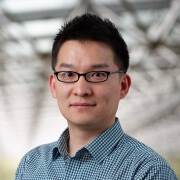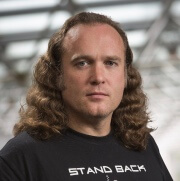New mirror made for quantum research could catch counterfeit cash
Monday, April 13, 2020 En français Researchers at the University of Waterloo’s Institute for Quantum Computing (IQC) have developed a new kind of mirror that could be used to protect against counterfeit banknotes. Photons—quantum particles of light—can be left or right-handed, like humans. In some applications, researchers need to be able to sort left […]
April 13, 2020
Advanced microwave electronics enabling quantum technologies
Summary Superconducting quantum computers require quantum-limited measurements at microwave frequencies in order to implement error correction. Conventionally, this is accomplished using near quantum-limited Josephson Parametric Amplifiers (JPAs). The JPAs require bulky ferrite-based circulators that prevent on-chip integration of the amplifiers with the processor and take up the majority of space and cooling power in the […]
April 1, 2020

Quantum Material Multilayer Photonic Devices and Network
Summary Realizing highly integrated quantum photonic devices on a chip can enable new opportunities for photonic quantum computation. In this project, we explore heterostructures of stacked two-dimensional (2D) materials, such transition metal dichalcogenides (TMDC) or graphene, combined with optical microcavities as a platform for such devices. 2D materials are extremely thin and flexible, and have […]
December 12, 2019

Na Young Kim and Zbigniew Wasilewski discuss Advanced & Evolving Materials at the Waterloo Defence Research Forum
Na Young Kim and Zbigniew Wasilewski discuss Advanced & Evolving Materials at the Waterloo Defence Research Forum Event held on Thursday, October 10, 2019 The Waterloo Defence Research Forum discussed topics ranging from critical issues in cybersecurity to advances in autonomous technologies. As part of the forum, Na Young Kim and Zbigniew Wasilewski highlighted their TQT […]
October 10, 2019

Free-space Polarization-selective Microcavity based on Chiral Metasurfaces
Summary Developing a new type of Fabry-Pérot cavity that allows improved control of the atoms’ emission into the cavity mode will result in enhancement of the efficiency and fidelity of quantum state transfer from photons to atoms and back. This in turn can be used to improve the performance of quantum networks and repeaters, as […]
September 19, 2019

Novel Infrared Camera Based on Quantum Sensors for Biomedical Applications
Summary In this project we develop a novel infrared camera with low noise and high detection efficiency for biomedical applications of optical coherence tomography (OCT) using quantum materials. OCT is a technique used to image the back of the eye and allow for the diagnosis of detrimental eye conditions, for e.g., macular degeneration, diabetic retinopathy […]
March 13, 2019

Hybrid Quantum Repeater based on Atomic Quantum Memories and Telecom Wavelength Entangled Photon-Pairs Generated from Semiconductor Nanowires
Summary Losses in physical channels, such as optical fibres, limit existing quantum communication systems to modest distance ranges. Since amplification of quantum signals is fundamentally not possible, we look to extend the range and functionality of these quantum channels by adding quantum memory nodes that can daisy-chain multiple lengths of quantum channels through entanglement […]
October 29, 2018

On-Chip Microwave-Optical Quantum Interface
Summary In this project we develop a quantum interface between microwave and optical photons as a key enabling technology of a hybrid quantum network. In such a network, the robust optical photons carry quantum information through optical fibres over long distances, while superconducting microwave circuits protected from thermal photon noise by the low temperature […]
October 29, 2018

Chiral Quantum Antenna Based on Multilayer Metasurface
Summary Individual atoms can act as stationary qubits and thus serve as nodes in quantum computing networks or as memories for quantum repeaters. However, to successfully use qubits based on single atoms suspended in free space, photons emitted by a single atom need to be efficiently collected. Conventionally, this can be done with high […]
September 20, 2018
Spin-transfer Torque Magnetic Random Access Memory for On-chip Spin Information Storage
Summary Leakage power in semiconductor memories, such as Dynamic Random Access Memory (DRAM) and Static Random Access Memory (SRAM), can be substantial and is one of the limits for scalability of classical electronics. This is attributed to the fact that the information stored is volatile, requiring constant refreshing, as well as reprogramming upon powering […]
August 6, 2018

Quantum Light Sources Based on Deterministic Photon Subtraction
Summary This project develops new sources of light that utilize quantum entanglement to enhance imaging resolution and detection. We aim to go beyond simple photon pairs and advance our understanding and control of new quantum states of light. Our approach uses deterministic single-photon subtraction (removing of a specific photon from a pulse of light) […]
July 13, 2018

Cryo-CMOS to Control and Operate 2D Fault-Tolerant Qubit Network
Summary Large-scale, fault-tolerant quantum computation requires precise and stable control of individual qubits. This project will use complementary metal-oxide-semiconductor (CMOS) technology to provide a cost-effective scalable platform for reliable and high-density control infrastructure for silicon spin qubits. We will use sub-micron CMOS technology to address device and circuit-level challenges and explore the integration of […]
June 14, 2018

Harnessing the Promise of Quantum Materials for Future Electronic Devices
Summary Two-dimensional (2D) quantum materials, such as graphene and molybdenum disulfide, have great potential for use in future flexible and wearable electronics applications. With traditional silicon-based electronics nearing their theoretical performance limits, nano-electronics made from 2D quantum materials offer breakthrough opportunities for energy-efficient, wearable ubiquitous computation. In this project, we will study integration of […]
June 14, 2018

Assistant Professor, Electrical & Computer Engineering
October 9, 2017

Professor, Electrical & Computer Engineering
October 6, 2017

Quantum Simulation of Strongly Coupled Field Theories
Strongly-coupled field theories describe both fundamental and applied quantum problems.
August 10, 2017

Development of Terahertz Polariton Lasers
Theoretical and experimental results show that the polariton lasing mechanism is a promising basis for a compact, efficient source of terahertz radiation.
July 1, 2017

Carbon Nanotube Monolayer Josephson Junction Superconducting Qubit
Carbon nanotubes (CNTs) are a promising material for use in Josephson-Junctions (JJs) given their unique properties, such as high electrical conductivity, pristine surface, inherent nanoscale dimension, and silicon-compatible processing
June 1, 2017

Next Generation Quantum Sensors
We are developing new semiconductor p-n junctions and designing novel nanowire arrays that have the potential to significantly enhance the ability to detect light at the single photon level over an unprecedented wavelength range from the ultraviolet to infrared.
June 1, 2017

Distributing Multimode Entanglement with Microwave Photons
Microwaves have enabled numerous classical technologies, in part because they propagate through air with little energy loss.
March 6, 2017

